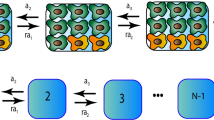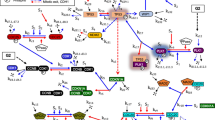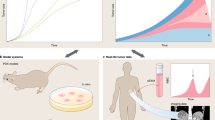Abstract
Mathematical models are used to examine the relationship between checkpoint competence, ageing, and the development of cancer. The models take into account the dynamics of healthy tissue, the dynamics of initial tumor growth, and the interactions between healthy tissue and tumor cells. Two types of behavior are found. (i) A reduction of checkpoint competence results in reduced ageing of tissue, but in faster development and progression of tumors. (ii) Reduced checkpoint competence results both in reduced ageing of tissue, and in a reduced incidence of tumors. The tumors which do become established, however, are predicted to progress at an accelerated rate. The models define the conditions under which this counter-intuitive finding is observed. One reason could be the relationship between checkpoint activity and the ability of the tissue environment to exert inhibitory effects on tumor cells. Checkpoints induce senescence in tissue cells, and this compromises their ability to suppress tumor growth. Reduced checkpoint competence leads to reduced tissue senescence, and this results in higher amounts of tumor inhibition. The theoretical work is discussed with respect to data from p53 mutant mice, which show both types of relationships suggested by the models. The models help to identify differences in the experimental protocols which could explain the seemingly contradictory observations.
This is a preview of subscription content, access via your institution
Access options
Subscribe to this journal
Receive 50 print issues and online access
$259.00 per year
only $5.18 per issue
Buy this article
- Purchase on Springer Link
- Instant access to full article PDF
Prices may be subject to local taxes which are calculated during checkout






Similar content being viewed by others
References
Bayko L, Rak J, Man S, Bicknell R, Ferrara N and Kerbel RS . (1998). Angiogenesis, 2, 203–217.
Blagosklonny MV . (2002). Int. J. Cancer, 98, 161–166.
Campisi J . (2001). Scientific World J., 1, 65.
Campisi J . (2003). Nat. Rev. Cancer, 3, 339–349.
Camplejohn RS, Gilchrist R, Easton D, McKenzie-Edwards E, Barnes DM, Eccles DM, Ardern-Jones A, Hodgson SV, Duddy PM and Eeles RA . (2003). Br. J. Cancer, 88, 487–490.
Chavez-Reyes A, Parant JM, Amelse LL, de Oca Luna RM, Korsmeyer SJ and Lozano G . (2003). Cancer Res., 63, 8664–8669.
Cunha GR and Matrisian LM . (2002). Differentiation, 70, 469–472.
Donehower LA . (2002). J. Cell. Physiol., 192, 23–33.
Evans SC and Lozano G . (1997). Mol. Med. Today, 3, 390–395.
Finkel T and Holbrook NJ . (2000). Nature, 408, 239–247.
Folkman J . (2002). Semin. Oncol., 29, 15–18.
Folkman J and Kalluri R . (2004). Nature, 427, 787.
Gilhar A, Ullmann Y, Karry R, Shalaginov R, Assy B, Serafimovich S and Kalish RS . (2004). Br. J. Dermatol., 150, 56–63.
Guba M, Cernaianu G, Koehl G, Geissler EK, Jauch KW, Anthuber M, Falk W and Steinbauer M . (2001). Cancer Res., 61, 5575–5579.
Hahnfeldt P, Panigrahy D, Folkman J and Hlatky L . (1999). Cancer Res., 59, 4770–4775.
Hasty P, Campisi J, Hoeijmakers J, van Steeg H and Vijg J . (2003). Science, 299, 1355–1359.
Hsu MY, Meier F and Herlyn M . (2002). Differentiation, 70, 522–536.
Itahana K, Dimri G and Campisi J . (2001). Eur. J. Biochem, 268, 2784–2791.
Jansen-Durr P . (2002). Scientific World J., 2, 943–948.
Kahlem P, Dorken B and Schmitt CA . (2004). J. Clin. Invest., 113, 169–174.
Kemp CJ, Donehower LA, Bradley A and Balmain A . (1993). Cell, 74, 813–822.
Kirkwood TB . (2002). BioEssays, 24, 577–579.
Komarova NL and Wodarz D . (2003). Cancer Res., 63, 6635–6642.
Lengauer C, Kinzler KW and Vogelstein B . (1998). Nature, 396, 643–649.
Mueller MM and Fusenig NE . (2002). Differentiation, 70, 486–497.
Offer H, Erez N, Zurer I, Tang X, Milyavsky M, Goldfinger N and Rotter V . (2002). Carcinogenesis, 23, 1025–1032.
Oren M . (2003). Cell Death Differ., 10, 431–442.
Parrinello S, Samper E, Krtolica A, Goldstein J, Melov S and Campisi J . (2003). Nat. Cell. Biol., 5, 741–747.
Schmitt CA . (2003). Nat. Rev. Cancer, 3, 286–295.
Sharpless NE and DePinho RA . (2002). Cell, 110, 9–12.
Tlsty TD . (2001). Semin. Cancer Biol., 11, 97–104.
Tlsty TD and Hein PW . (2001). Curr. Opin. Genet. Dev., 11, 54–59.
Tyner SD, Venkatachalam S, Choi J, Jones S, Ghebranious N, Igelmann H, Lu X, Soron G, Cooper B, Brayton C, Hee Park S, Thompson T, Karsenty G, Bradley A and Donehower LA . (2002). Nature, 415, 45–53.
Vogelstein B, Lane D and Levine AJ . (2000). Nature, 408, 307–310.
Acknowledgements
I would like to thank Chris Kemp for many useful discussions and comments.
Author information
Authors and Affiliations
Corresponding author
Rights and permissions
About this article
Cite this article
Wodarz, D. Checkpoint genes, ageing, and the development of cancer. Oncogene 23, 7799–7809 (2004). https://doi.org/10.1038/sj.onc.1207833
Received:
Revised:
Accepted:
Published:
Issue Date:
DOI: https://doi.org/10.1038/sj.onc.1207833
Keywords
This article is cited by
-
Involvement of nuclear factor of activated T cells 3 (NFAT3) in cyclin D1 induction by B[a]PDE or B[a]PDE and ionizing radiation in mouse epidermal Cl 41 cells
Molecular and Cellular Biochemistry (2006)



